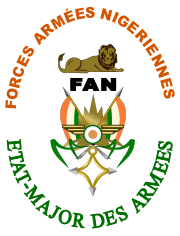Our website is made possible by displaying online advertisements to our visitors.
Please consider supporting us by disabling your ad blocker.
Niger Armed Forces
| Niger Armed Forces | |
|---|---|
| Forces armées nigériennes | |
 Seal of the Niger Armed Forces | |
| Founded | 1 August 1961 |
| Service branches | Army Air Force National Gendarmerie National Guard (GNN) |
| Headquarters | Niamey |
| Leadership | |
| Commander-in-Chief | Brigade General Abdourahamane Tchiani |
| Chief of Staff | Divisional General Abdou Sidikou Issa |
| Personnel | |
| Military age | 18–49 |
| Conscription | 2 year compulsory[1] |
| Available for military service | 2,135,680 (2005 est.), age 15–49 |
| Fit for military service | 1,155,054 (2000 est.), age 15–49 |
| Active personnel | 25,000 (2020 est.) [2] |
| Expenditure | |
| Percent of GDP | 1.8% (2017 est.) [1] |
| Industry | |
| Foreign suppliers | North Korea Russia South Africa Algeria Georgia (country) |
| Related articles | |
| History | Tuareg rebellion (1990–1995)[4] Tuareg rebellion (2007–2009)[5] United Nations Operation in Côte d'Ivoire[6] Boko Haram insurgency[6] Islamist insurgency in the Sahel[6] 2023 Nigerien coup d'état Nigerien crisis |
| Ranks | Military ranks of Niger |

The Niger Armed Forces (French: Forces armées nigériennes, FAN) includes military armed force service branches (Niger Army and Niger Air Force), paramilitary services branches (National Gendarmerie of Niger and National Guard of Niger) and the National Police of Niger. The Army, Air Force and the National Gendarmerie are under the Ministry of Defense whereas the National Guard and the National Police fall under the command of the Ministry of Interior. With the exception of the National Police, all military and paramilitary forces are trained in military fashion. The President of Niger is the supreme commander of the entire armed forces. The National Assembly of Niger passed a statute for the Army of Niger in November 2020, planning for the army's size to increase from 25,000 personnel in 2020, to 50,000 in 2025 and finally 100,000 in 2030.[7]
- ^ a b Niger — the World Factbook Archived 2021-03-30 at the Wayback Machine. Retrieved 10 March 2021.
- ^ "Niger: les effectifs de l'armée vont doubler d'ici cinq ans". Archived from the original on 2023-04-16. Retrieved 2023-08-03.
- ^ Niger junta revokes military pacts with France
- ^ Six éléments des Forces Armées nigériennes rejoignent les rebelles au Nord Archived 2008-03-05 at the Wayback Machine. APA, 24 May 2007.
- ^ Iférouane, prise en étau, se vide de ses habitants Archived 30 September 2007 at the Wayback Machine. Agence France-Presse: 27 August 2007.
- ^ a b c Cite error: The named reference
desert warriorswas invoked but never defined (see the help page). - ^ "Ministère de la défense nationale | Forces Armées Nigériennes". www.defense.gouv.ne. Archived from the original on 2023-08-04. Retrieved 2023-08-04.
Previous Page Next Page
القوات المسلحة للنيجر Arabic Въоръжени сили на Нигер Bulgarian Streitkräfte Nigers German Fuerzas Armadas Nigerinas Spanish Forces armées nigériennes French Rundunar Tsaron Nijar HA Oružane snage Nigera Croatian Niger hadereje Hungarian Вооружённые силы Нигера Russian Forcat e Armatosura të Nigerit SQ


